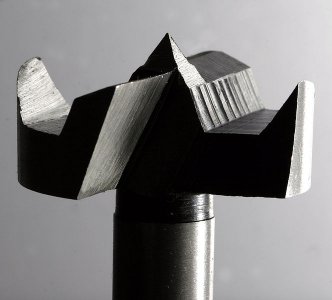Mainly my problem is the plastic loading up in the teeth and welding on. This can happen within about 3 (slow) revolutions if I don't back out and clear it. Usually I'm doing hole diameters from 1 to 4 inches diameter in plastic up to 3/4" thick, sometimes even larger diameters, and thicker plastics. On thinner stuff the teeth aren't buried much below the surface, so I can be more patient because the work is soon done, but once the shallow waste of a standard Bi-Metal holesaw sink below the surface, about 3 revolutions of good cutting is all you get before having to clear it.
On a standard holesaw, I remove some teeth leaving the alternately set ones(about every third or fourth one), then I sharpen what remains. I make a huge waste gullet between the remaining teeth which affords more depth and dwell time before having to clear. I think whether or not the teeth are widely set, the chips are able to float onto the sides and scrub anyway, and then they melt and weld on. This is even with compressed air, water, soap, etc. So I was attracted to the huge cemented carbide cutter design which would seem to counter this action and be a little more self-clearing. The ones I have found so far are all very thick and require a lot of pressure, more than I expected. Heavy pressure is bad for exiting the work, and it requires a heavier setup all around. Sandwiching the material would help prevent breakage, but I do a lot of symmetrical arrays designed to allow me to both flip and rotate the work to make multiple use of each current setup position, and additional materials can complicate things.
So, what I am hoping for is a compact but sturdy trepanning tool that can allow me to insert a common but specially ground-by-me tool bit that will remain stable throughout the operations, and preferably one that will produce a self-clearing chip. I would love it if I could have that in a single cutter tool so that I didn't have to fuss when adjusting the diameter. Hmm, sounds like a boring head.
A boring head would only work if the setup is rigid and doesn't require the use of a pilot.
It would also be nice if I could have this large-deep-hole cutting functionality with a portable drill, which seems to suggest a 3-cutter design. I've had one of those scroll adjusted 3-blade "holesaws". They're small, weak, and loose, so I don't think much of it for repeatable work. For one-off shallow cuts, maybe good until dulled. If there was a more sturdy one like that, .... it could work.... I wonder.....
Dave


